Chapter I -3 :Quality of the Environment in Japan 1997
Chapter IV : State of the Environment
Environmental issues in the past were mainly confined to severe pollution cases and instances where nature was destroyed. Such cases were caused by specific social/economic activities in specific areas. By contrast, in recent years, ordinary business activities and people's daily activities are leading to increasing pressure on the environment and this can generate global environmental problems, or problems that will be passed down to our future generations.
In addition, environmental problems can spread over wide areas, and can have long-term and often irreversible effects. Some of these problems have irreversible effects. Some of these problems have the potential to inflict health hazards for many decades, and the process of recovery for a damaged environment is often very difficult.
In this year's paper, the global warming issue is discussed in depth in Chapter I and waste/recycling issues are discussed in depth in Chapter II.
Ozone Layer Depletion
The ozone layer is depleted when substances such as chlorine are created in the stratosphere as a result of the decomposition of CFCs and other gasses. When the ozone layer is depleted, the amount of ultraviolet rays reaching the surface of our planet increases. This, in turn, imposes negative effects on human health and has the potential to cause damage to various ecosystems.
In Antarctica, the quantity of ozone has been depleted every spring since the end of the 1970s, and this phenomenon has become known as the "ozone hole." 1996 saw the biggest hole in the ozone cover yet, making 1996 the fifth consecutive year that the ozone hole has been the largest ever recorded.
The serious nature of recent ozone depletion has prompted the signing of the Montreal Protocol and its enforcement. And international efforts continue to realise the reduction of, and ultimately, a complete ban on, ozone depleting substances.
 |
Ozone Concentration Map TOMS data of the Nimbus (NASA) Meteorology Agency Average figures for Oct. 1979 |
| Meteorology Agency Average figures for Oct. 1996 |
|
| Photo: Courtesy of the Meteorological Agency |
Acid Rain
Acid rain is rain with high levels of acidity and is created when rainwater mixes with the sulphuric acid and nitric acid that is transformed from air pollutants such as sulphur oxides and nitrogen oxides. It is feared that acid rain will acidify lakes, marshes and rivers, doing harm to fish and other forms of wildlife. It is also feared that acid rain will acidify soil, exerting a negative influence on woodlands. It will also damage our cultural heritage.
European-levels of acid rain have been recorded in large areas of Japan, and it is inferred from this that the possibility of the impact on the ecosystems becoming apparent in the future cannot be denied.
Acid rain is a trans-regional environmental problem, which can have an effect thousands of kilometres away from the source of emissions. In order to implement effective acid rain counter-measures, due to the problem's trans-regional character, international co-operation is indispensable. In recent years, in the East Asian region, there have been increasing levels of sulphur oxides and nitrogen oxides emissions.
Acid Rain in Japan (The Second Survey for Acid Rain Measures) 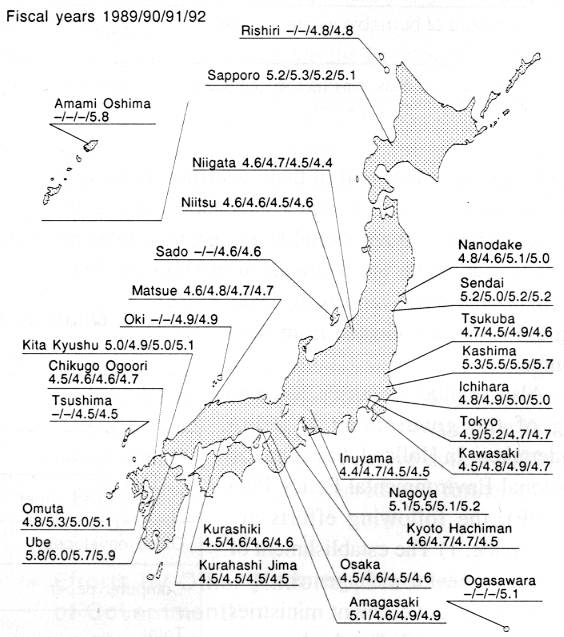
Source: Environment Agency
Air Pollution Caused by Nitrogen Oxides
In Japan, the concentration of sulphur dioxide and carbon monoxide in the air falls within acceptable limits. However, when it comes to nitrogen dioxides and suspended particulate matter, the achievement rates of the Environmental Quality Standards have been low, Nitrogen dioxide, when its concentration in the air is high, has undesirable effects on the respiratory organs. As a nitrogen oxide, such as nitrogen monoxide, it is also a cause of acid rain and photochemical pollution. Therefore further measures have to be promoted to counter this problem.
Suspended particulate matter is composed of very fine substances, under 10 microns in diameter, which float suspended in the air. Due to their very small size, these tiny particles remain in the air for a long time and consequently affect people's respiratory organs. Corpuscles in diesel smoke, in particular, are suspected to play a contributing role in the development of diseases such as cancer, asthma and hay fever.
Changes in Annual Average NO2 Concentration
(Average of Continuously Monitoring Stations)
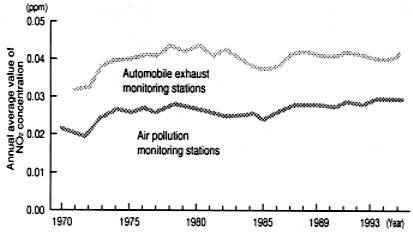
Source: Environment Agency
Noise, Vibration and Offensive Odour
Problems such as noise, vibration and offensive odour are intimately connected with the immediate senses of the general public. Solving these problems is an important task in order to protect our immediate living environment. Although the number of complaints made for each category of problem is decreasing every year, it still holds a major share in the total number of pollution-related complaints made to the authorities. Furthermore, the causes for this category of complaint are becoming more diversified.
Highest among the list of pollution-related complaints are those regarding noise pollution. In particular, complaints against traffic noise are very common and the promotion of comprehensive measures to counteract this problem are needed.
As for offensive odours, the number of complaints from service industries and households in urban and residential areas is increasing. Measures to prevent compound odours, and offensive odours released in the course of the activities which go to make up our daily lives, are being implemented.
Changes in Number of Grievances in Typical Cases of Pollution by Type
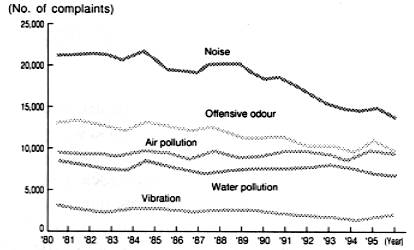
Source: Environmental Dispute Coordination Commission
Water Pollution in Oceans, Rivers and Lakes
Regarding the state of water pollution in Japan, in this and in the last year, the criteria laid out in the Environmental Quality Standards are mostly satisfied concerning those toxic substances that are actually included in the Environmental Quality Standards system. However, as much as 30% of oceans, rivers and lakes fails to meet the criteria laid out in the Environmental Quality Standards when it comes to the problem of organic contamination. In particular, in closed aquatic environments and urban rivers and waterways, the pollution level is still very high.
In closed aquatic environments such as lakes, marshes and inner bays, pollutants are more likely to accumulate, which makes it more difficult to improve or maintain water quality. In particular, the Environmental Quality Standards achievement rate is low in lake and marsh environments. This, in turn, is causing strange odours in tap water, and is having an impact on fisheries activities. Also, because of household effluent, the environmental pressure on urban rivers and waterways is increasing.
Changes in the Achievement Rate of Environmental Quality Standards
(BOD or COD)
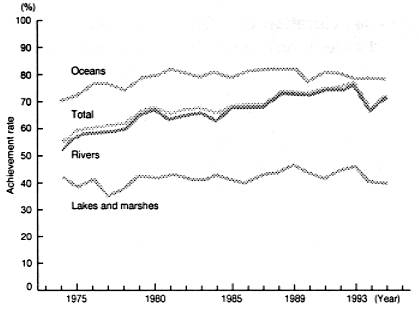
Source: Environment Agency
Marine Pollution
The oceans are often the final destination of pollutants. Although the oceans are vast, human activity-induced pollution has been identified throughout the world. In 1996, 754 cases of marine pollution around Japan were reported by the Maritime Safety Agency. Of these 754 cases, 370 involved oil pollution, 294 were caused by other pollutants such as disposed waste, toxic liquids and industrial discharge, and 90 were caused by red tides.
Underground Water
Underground water is a precious fresh water resource. However, since the early 1980s, some underground water reserves have been contaminated with organic chlorine compounds. The causes for this are considered to be mainly toxic substances, effluent which contains these toxic substances, and inappropriate waste management procedures. In addition, underground water contamination caused by nitrate nitrogen has begun to make itself noticed. The causes for this contamination are household waste water discharge, agricultural waste resulting from cattle farming, and runoff from areas that are targeted by intensive farming methods reliant on the consumption of large quantities of fertiliser.
Soil Contamination and Land Subsidence
Soil is an element that forms an integral part of the natural environment. Inorganic and organic matter, micro-organisms and wildlife all utilise soil in some way or another during their natural cycle of substance circulation. Moreover, soil is essential for human life. It is the foundation for agriculture and an important natural resource. Soil creates underground water reserves, possesses the capacity to retain water and maintains ecosystems. Soil contamination is a long-term problem: contaminants accumulate and have a long lasting impact, and it is very difficult to improve contaminated soil or return it to its original state.
Regarding soil on agricultural land, 7,140 ha of land has been identified as contaminated, of which 74.2% has been treated. The 1994 investigation revealed 232 contamination cases since 1975, and the number of new cases has been increasing in recent years.
Regarding land subsidence, restrictions on underground water pumping have improved the overall situation. However, in some regions, a significant amount of subsidence is still reported.
Moreover, urbanization has prevented water from penetrating into the soil and has caused the deterioration of some soil's water retention capacity. It is feared that this, in turn, reduces the amount of underground water available.
Ground Subsidence Nationwide in Fiscal 1995
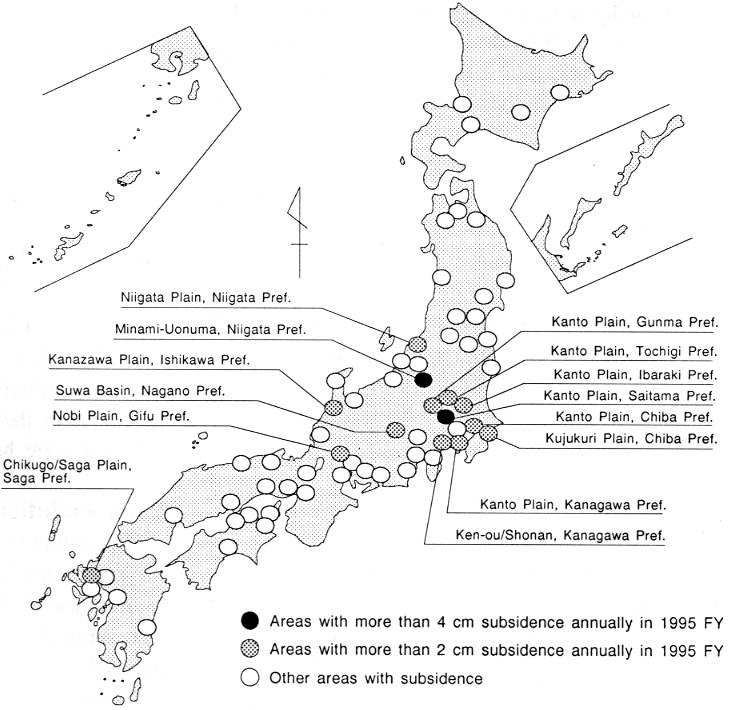
Zoom in
Source: Environment Agency "Ground Subsidence Nationwide in Fiscal 1995"
Japan's Vegetation Cover
Japan has one of the highest percentages of forest cover remaining among the world's nations. As much as 67% of the entire country is covered with forests and 92.5 percent of the country is covered with some form of vegetation cover. In cities, however, large spaces with no form of vegetation cover are increasing in size, and natural environments are increasingly confined to limited areas in the urban context.
Of Japan's naturally forested areas, nearly 60 percent can be found in Hokkaido. The majority of other naturally forested areas are to be found in the mountain regions of Tohoku and Chubu, and also along the Japan sea coast and in Okinawa. In the Kinki, Chugoku and Shikoku regions, naturally forested areas are very small, and are largely relegated to the higher regions of mountains, and peninsulas and islands.
Classification of Vegetation Zones in Japan (Regional)
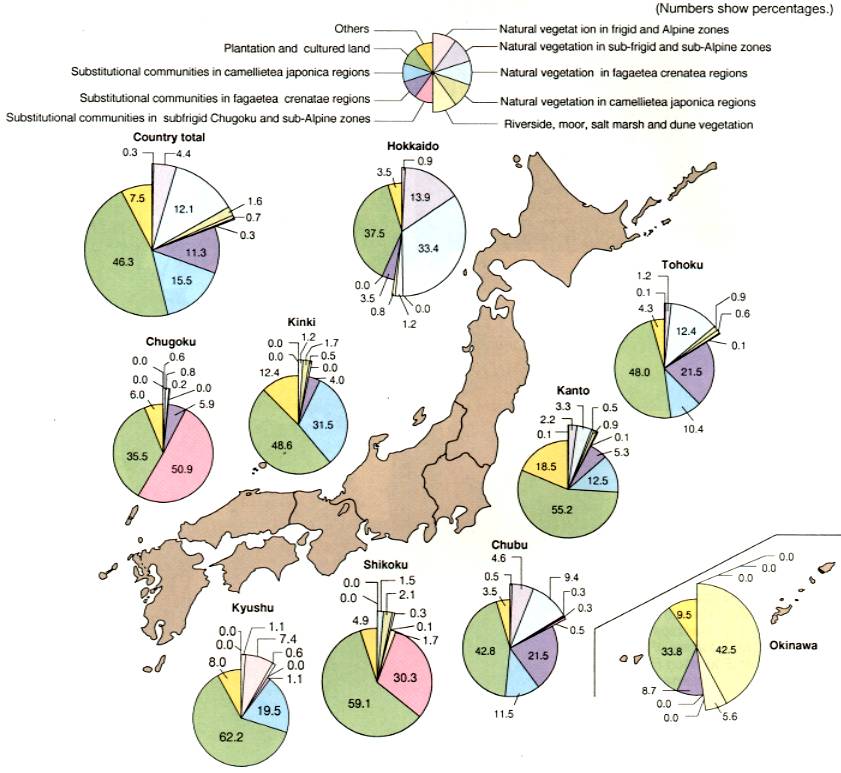
Source: The Fourth National Survey on the Natural Environment (Vegetation Survey), Environment Agency
Zoom UP
Disappearing Tropical Forests
Tropical forests play an important role in the maintenance of the global environment, absorbing CO2 and regulating the water balance and the heat radiation from the earth. Tropical forests also perform the highly important function of maintaining biodiversity. The rapid destruction of tropical forests in recent years not only exhausts forest resources but also undermines biodiversity. Moreover, it is feared that the large quantities of CO2 emissions resulting from forest destruction might serve to accelerate the process of global warming.
Untraditional slash and burn agriculture and excessive logging are often pointed out as being causes of tropical forest destruction. However, behind this phenomenon, there are also social and economic factors such as poverty, the increase in human population and issues of land tenure.
Protection of the Antarctic Environment
In Antarctica, there exists a highly special and fragile ecosystem which has evolved adapting to the severe natural environment of the continent. The importance of this environment, which has had such minimal human contamination, is attracting much attention. Since the 1961 Antarctic Treaty, the Antarctic region has been utilised as a scientific observation base, and environmental impact resulting from the activities of the bases and the increasing number of tourists is feared. Given this situation, in 1991, the Law Relating to Protection of the Environment in Antarctica was adopted. In Japan, "The Bill on the Protection of the Antarctic Environment" was submitted at the 140th Diet session in order to conclude the Law.
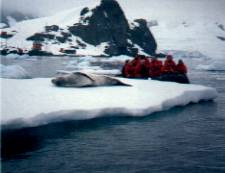
Tourists in Antarctica, watching seals
Endangered Wildlife
Human beings have historically survived by utilising wildlife resources as food, and as materials for tools, clothing etc. These activities, however, sometimes led to over-hunting. Moreover, the growth and spread of human economic/social activities has also contributed to the destruction of wildlife and wildlife habitat.
In Japan, threatened and endangered species are designated as "national endangered species" and measures are being taken to protect them. Presently, 22 extinct animal species and 110 endangered animal species have been officially recognised. As for plant species, it has been reported that 147 are listed as almost extinct, and 677 as endangered.

Blakiston's fish owl
Interacting with Nature
In recent years, as people's environmental awareness rises and, at the same time, as natural areas disappear from the urban environment, there is an increasing need on the part of the general public to interact with nature. In 1995, 971.01 million people visited nature parks in Japan.
Heat Island and Artificial Light Pollution
In metropolitan areas, the massive consumption of energy combined with the predominance of asphalt ground cover in the form of streets, prevents the drop in night time temperatures that would otherwise be caused by water evaporation. This is called the "heat island" phenomenon.
Furthermore, the problem of excessive artificial light has recently been drawing attention. Artificial light eliminates the possibility of observing the beautiful panorama of stars and constellations in the night sky. Excessive artificial light levels might also have a negative effect on wildlife ecology. Additionally, one piece of research concluded that the bigger cities grow, the less easy it becomes to see the stars.
Moreover, research is being conducted to investigate the health hazards posed by electromagnetic waves and the mechanisms that underlie the type of hay fever which is induced by cedar trees.
Brightness of Japan's Night Sky
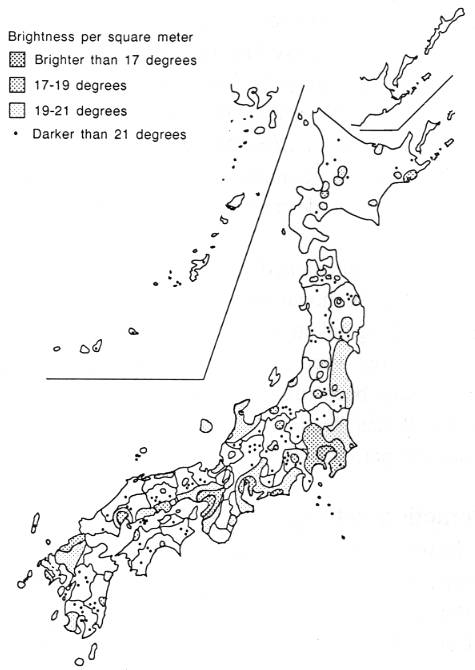
Source: Environment Agency
Environmental Impact of the Nakhodka Oil Spill
The Russian tanker M.V. Nakhodka sank off Oki Island in Shimane Prefecture. Its bows were broken and sank, then drifted near to the shore of Mikuni town, Fukui Prefecture. The oil released from M.V. Nakhodka drifted ashore in 9 prefectures, but the majority of it washed up in Fukui. The damage this inflicted on the marine environment, including seabirds and fisheries, has been phenomenal. The Government established the "Oil Pollution Response Headquarters for Nakhodka Incident," headed by the Transport Minister, and took various emergency measures. It is urged that every possible effort is made to restore the damaged environment as quickly as possible, and that a system to cope with such emergencies both quickly and adequately should be established.
Because it takes a long time for oil spilled by tankers and other vessels to dissolve and be absorbed into the natural environment, and because, therefore, oil spills have significant impacts on the marine ecosystems, international efforts such as the OPRC Treaty and the Ocean Pollution Prevention Treaty are being conducted to prevent and cope with future emergency incidents.
Location of the Drifted Bow and the Status of Spilled Oil
(As of 17:00 pm, January 23, 1997)
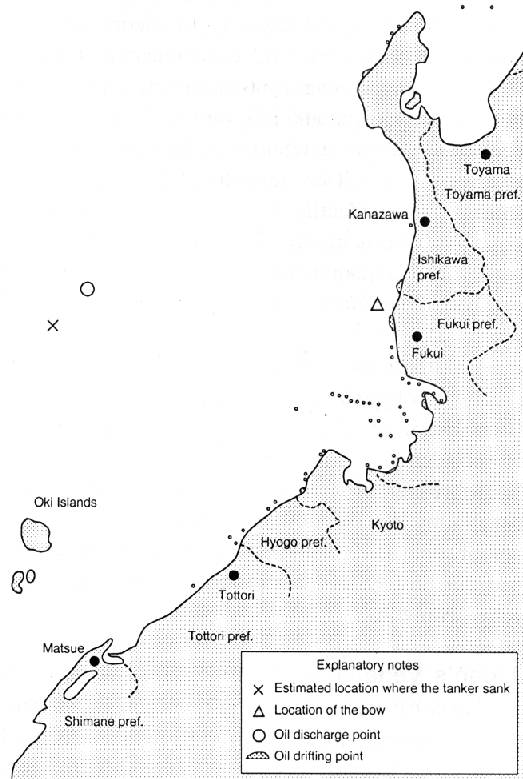
Source: Maritime Safety Agency